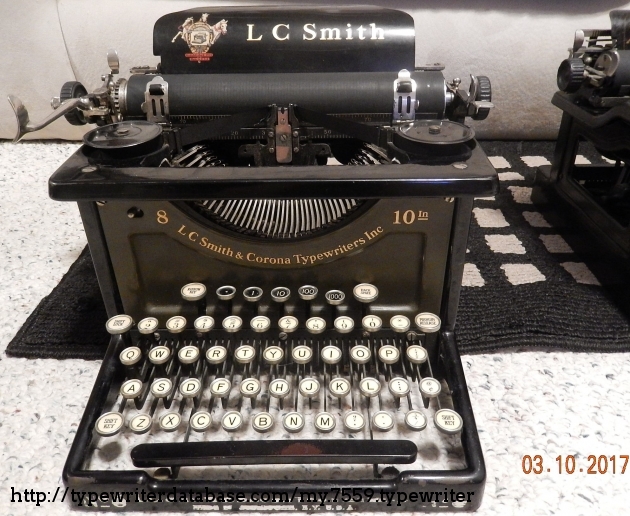
- OliverNo.9
- Touch Typist
 Offline
Offline 
- From: CT
- Registered: 02-4-2016
- Posts: 140
KHT - KMM - KMG - What are the big differences?
Hello all,
on Ebay I just spotted a Royal KHT and noticed that it DOES have magic margins (I had been under the impression that Magic Margins started on the KMM). Before this (some months back) I was wondering what the differences were between the KMM and the KMG. I have owned both a KMG and a KMM but I have only noted the paint and a few other cosmetic features being different.
My question is, Royal had three similar machines (KHT, KMM, and KMG), why did they change the designation but keep the design very much the same? What changed between each model?
If anyone can shed some light on the BIG differences between the three models, I would really like to find out.
Thanks in advance. OliverNo.9
- Fleetwing
- Typewriter Talk Vet
 Offline
Offline - From: Hartford, CT USA
- Registered: 30-6-2015
- Posts: 1,022
Re: KHT - KMM - KMG - What are the big differences?
I don't know anything about the KHT. As for the KMM and KMG, I do believe the only differences were cosmetic -- gray color for the KMG (hence the "G") and the tombstone shaped keys. But I'm happy to be proven wrong!
- TypewriterKing
- Inactive Account
 Offline
Offline - From: DeepInTheHeartO', Texas
- Registered: 17-2-2016
- Posts: 1,011
Re: KHT - KMM - KMG - What are the big differences?
The KHT, introduced in 1938, was a refined generation upward from the KHM, in that it had a full cover over the ribbon spools instead of individual magazines, had a tab clear and tab set keys on the front instead of just the tab set on the keyboard, and was painted mostly in wrinkle-finish black. It did still retain a tab clear lever on the back of the tabulator mechanism cover. The margin release actuated when the tabulator was used, and that taxed the levers a bit--as was partly evidenced by the adjustments I have had to make on some of these machines.
Later in 1938, and running until early 1949, taking out for war production in 1943 and 1944, the KMM had its run. It was an improvement in design over the KHT, in that the tabulator mechanism was improved, and the tab above it was gone.
Sometime, perhaps in 1946 or 1947, changes such as square shift keys instead of round ones, a flattened carriage return lever stem instead of the earlier rounded one, black feet tops instead of chrome, and the use of aluminum shell casings instead of cast iron were seen. Otherwise, they were still the same machine.
In early 1949 to about mid-1952, the KMG made its run. Essentially, it was an extension of the KMM, but the machines were painted a gunmetal grey, all the keys were tombstone shape, and there was a quick platen removal mechanism on the right side of the carriage.
This is the history as it was made known to me--through the typewriter database, and all of the Royal upright (standard) typewriters I've serviced in the last 35 or so years--and there have been many, as Royal was a very popular product. From the pricings I've seen in the NOMDA "bluebooks," a Royal upright was cheaper to be had than say, an Underwood, or even more expensively, a Remington. Royal made a very good product--rough, rugged, and reliable. In fact, so reliable and solid were these machines that many have lasted well into the 21st century after performing many hours of long, hard work. The mighty HH Royals that came after them, and the FPs that came still after, were just as hardy.
Underwood--Speeds the World's Bidness
- TypewriterKing
- Inactive Account
 Offline
Offline - From: DeepInTheHeartO', Texas
- Registered: 17-2-2016
- Posts: 1,011
Re: KHT - KMM - KMG - What are the big differences?
I had forgotten to mention that the Magic Margin was first found on the KHT, and was unchanged to the last KMG. The HH, FP, RP, RE, and others after the KMG only had a slight change in which the margin setting was controlled: In these latter ones, you had to keep finger tension pulling the tabs forward until you got the carriage where you want that margin set, and release it there. On the early ones, you could just pull the tabs forward, let go of them, move the carriage to where you want the margins set, and push back on the margin control tabs, depending on which side you wanted to set. The KHM machines backward, and latter machines with extremely long carriages were set by hand. Adler-Royals and Imperial-Royals by Litton Industries are also set by hand.
Underwood--Speeds the World's Bidness
- OliverNo.9
- Touch Typist
 Offline
Offline 
- From: CT
- Registered: 02-4-2016
- Posts: 140
Re: KHT - KMM - KMG - What are the big differences?
TypewriterKing, Thank you for the explanation! I never really knew what fine details differentiated the three models from each other until now. I really appreciated it!
Thanks again. OliverNo.9
- •

 1 of 1
1 of 1